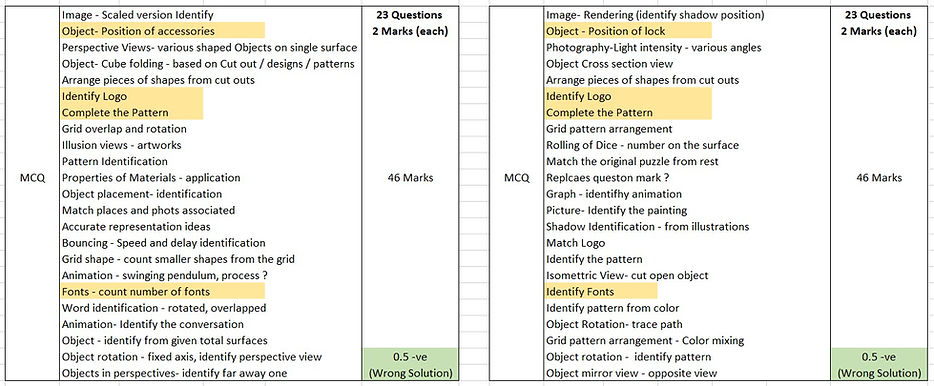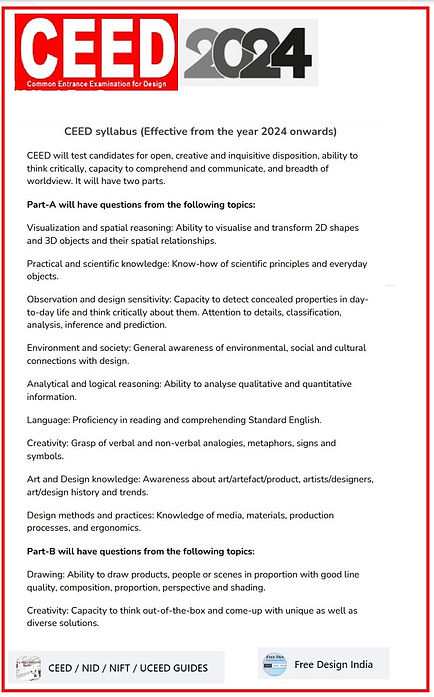
FreeDes
FREE Design Education

> Design Entrance Study materials for FREE. > Learn CEED, UCEED, NID, NIFT & NATA and crack exams for FREE.
Self Study Guide
Warmup Tips
Before starting with the preparation,
-
Take a note book, list out various
design streams available as per your interest. -
List out all those various types of design streams makes your skill improve.
-
List out what skills helps you earn more income as a career after your studies.
-
Explore various possibilities for the future in the design stream you are interested.
-
Understand trending design concepts and technical changes around the world.
-
Read articles, blogs and follow safe design channels on the internet.
-
Participate in design challenges and welcome failures positively.
-
Meet and Chat with fellow design aspirants for design preparation only.

Self Study Where to begin?
In this section lets deal on how to face the Design Exams as well as understand the latest trending updates in design. For Design exam preparation, I would recommend you to note down your difficulties in Sketching, rendering as well as
in solving various aptitude questions asked in exams.
The most important Skills to be successful in design as a career are
1) Technical Skills - Usage of software, Prototype Modelling, Rendering.
2) Sketching Skills - Expressing Ideas on Paper by doodling or sketching.
Few means of improving technical skills are, but not limited to learning Engineering Drawings, Understanding Perspective views, process involved in Manufacturing of various objects, practising random Autocad drawings.
Having an understanding about sustainable concepts in design helps the career grow helping the recruiters find feasible solutions in design through your ideology.


11) Creative designs
12) Books and Resources


10) Model Making

1) Mind Mapping
List out as many as you can which helps you with design preparation:
1) Websites and Apps
2) Similar Question Collection
3) Daily Sketching Practise
4) Daily GK Memorizing
5) Reading HIstory
6) Revising Topics
7) Softwares Learning
8) Idea Collection


9) Art Movements, Painters, Era
Self Identify Question Pattern

Question Patterns help to learn
and practise more questions of similar types. Also helps in solving questions at a faster pace where time management is challenging.
Lets take CEED Question Pattern
as an example. Identify similarity in questions and how they are merged for easy preparation and how it can help with revision too.
Q- Questions m- Marks

On comparing the Question Pattern from CEED 2021 & CEED 2020, we can easily group types of Questions asked and can have a basic understanding of what ques to be expected in upcoming exams in this same pattern.


From the above comparison we could easily identify the types of questions asked in CEED Exam. Next step is to list
out these topics and categorise them based on your understanding. Don't forget to list down the topics along with
your preparation notes and add more points into it as you find them during various preparation stages.
Self Categorise Topics
The following is listed as an example from the above list based on my feasibility with preparation. It is necessary for you to list out topic individually as per your level of understanding about the topics and time taken to solve the questions without the help of answer key. Easy way to categorise - Try attempting previous Question Paper Yourself with time, just like exam.

Not all Topics are listed out in the above so as to make the students list out the topics
themselves as Exploring Self- Makes the best learner. List out using Excel Sheets.
Create your Folders
After categorizing topics as per your understanding, make individual folders online (recommended) and sub folders. Save them in your Google / Online Drives. Saving online helps aspirants who are preparing along with professions in engineering/construction/maintenance domains as well as for one touch accessibility during revision.

Now create daily schedules as per your comfort ensuring to spare time everyday for making notes on daily basis
as per the topic covered. Use calendar to keep a note of topic covered per day by using sticky notes or reminder
in your smartphones. Other tasks to be covered as possible are:
1) Sketching - min 3 Hrs
2) GK Studies - min 1 Hr
3) Software Studies - min 2 Hr
4) Making bullet points to remember
Reading Static GK on daily basis can help to memorise effectively without much struggle thereby improving spoken english skills as well as helps to learn faster. Topics to be focused in Gk are all available in any Manorama Yearbook. Practise Aptitude as well as fundamentals in Basic Electronics, Engineering Mechanics and material science to crack written tests conducted by IITs after CEED for engineering graduates.
Create Your Timetable
Once the basic resources are collected, create a timetable accordance with your daily chores. In the beginning for two months following timetable is challenging after which body automatically adjusts to the scheduled tasks on scheduled
time thereby helping, complete the syllabus daily at a faster pace. My timetable - example.
Avoid following random timetable as those may not be suitable to your body type and pressuring yourself to do tasks way too long than your body can adjust never helps you to have a successful career in Design as well as in its preparation strategy. Body needs rest and food thrice a day.

FREE Medical assistance with individual tailored syllabus:
For students preparing for design exams having diabetics, cancer, color blindness, AIDS can contact admin with their genuine medical documents. All their challenges will be solved easily together with certified MBBS doctors and with professional designers.
FREE Carrier Guidance with job placements will be provided for these students as per availability in design industry,
Recommend: Modify your timetable after consulting with a doctor about your health level. Understand the diet you require as per the physician and start creating the time table and study schedules accordingly. Long duration of sitting for preparation can cause serious injury in the spinal cord there by causing chronic pain, depression and other side effects. Don't forget to include fruits and water rich content in your diet to keep your body healthy.
Schedule weekly Revision
These small booklets can be carried anywhere easily. Utilise them to note down things you forget easily for example, logo and brands, book and authors, color and emotions, etc
You can use them to doodle your ideas while you are doing something else an example, you went for a evening walk and found a toy or a ride
in children's park which can be modified for multi purposes. Take a pic
of the same in your mobile & jot- doodle in your notepad at that instant. This helps you to improve observation skills and still sketching abilities.
Learn Software Basics

FREE Softwares available in Design Exams section in this website. Use softwares to learn fundamentals in design from the tutorials available in youtube. These help in having an understanding in detail about perspective views, rendering of objects, isometric views, scaling of objects, shadow formation etc which helps in design exam preparation as well as for design interviews from
top-notch companies in the world.
For Free Guidance in fundamentals of softwares with installation, activation and troubleshooting, feel free to contact the admin of this website, who can assist you for FREE in his spare time at your own residence.
NOTE: This website or its platforms have not assigned any person or team to assist students under its platform. Those people who are assigned will be published in Let's Connect Section. Please avoid taking guidance from unknown people
or group as they are not genuinely guiding you but collecting Ideas from you for their startups or portfolio.
Create Portfolio while studying
Creating portfolios are the most confusing part during preparation of interviews for career as well as for all design college admissions. Portfolios represents your skills and talents in various media platforms which help interview panels understand you capability and expertise using softwares as well as in effective sketching.
1) Idea collection: Modified version of existing/ invented concept.
2) Research related Items: Google/any design websites/ online markets/ articles.
3) Compare Ideas with existing Designs/Products: Identify pros and cons/unique features/identify consumer requirements/ manufacturing process/ efficiency and quality.
4) Sketching the Prototype: Top, Bottom, front, back and side views/ operation, application procedure.
5) Modelling: Software usage/ online presentation.

Online Portfolio
References
Effective portfolio creation strategies followed around the world by professional designers and aspirants alike are listed
out in here for all future aspirants to improve and nurture good design aesthetics in their career. These are shared from
open sources in the web.
E- Portfolios:
For students, digital portfolios foster in-depth analysis and independence while fueling reflection, creativity, and authentic lifelong learning. For educators, portfolio programs work wonders for tracking and assessing student growth and are an invaluable way to provide constructive feedback.
Some students may have difficulties showing their
true strengths in traditional assessments but may be marvelous at expressing themselves through a video, music, art, spoken word, designs, codings, or creative writing mediums that are easy to embed into a digital portfolio.
Blogfolios:
That is, a digital portfolio/ePortfolio that’s built on a blogging platform. And while we’re talking semantics,
a blog is simply a type of website that often has some static pages and is regularly updated with posts. Blogs allow for feedback and interaction through comments.
Blogging can provide an environment in which, they explore the relationship between theoretical ideas & knowledge acquired from lectures and in self learning.
It is through the power of such modes learners gain a clearer vision, not only of the immediate demands of the curriculum, but even potentially of their future career paths.

Artifacts:
The work samples that provide evidence of learning, experiences, or goals. Artifacts include text, video, audio, images, and more.
Depending on the context, you might use examples from design coursework, co-curricular activities (design challenges, student clubs, etc.), work experiences and internships, community activities, or other experiences that represent you and your knowledge, skills, abilities, and ways of knowing.
Practise Design Thesis

1) Data Collection: Primary mode- data are collected by you, makes your research or study looks more original. In secondary modes- required details are collected from other sources helps in saving time and can expand the scope of your research, but it means you don’t have control over the content or reliability of the data.
2) Research Analysis: Quantitative Analysis - Usage of statistical methods, to analyse patterns and correlations between design parameters means you should clearly define your variables and formulate hypotheses about the relations between them. in Qualitative Analysis- you need to focus on identifying and categorizing key themes, interpreting patterns and narratives, or understanding social context and meaning .i.e., highlight approach used to analyse the design.
3) Thesis Proposal: Dissertation or thesis proposal describes exactly what you plan to do and how you plan to do it, showing your interviewer that your project is both practically feasible and capable of answering your research questions.
Few thesis examples are available in the University links, above. Majority of universities around the world conduct Design thesis exhibition for the world to see how design skills have improved technically with respect to technology. More of these can be found in Google search.
Create Thesis yourself
Follow the above three important steps to make a thesis yourself. Checkout step by step procedures in youtube. In case
any help is required for final product Rendering and animation, take help from mentors of any design colleges who have
20+ years of experience. Never take guidance from any Design college graduates and design preparation aspirants as majority of ideas get stolen and freshers especially ladies are more affected.
Understand Critiques
Critiques related questions are asked during uploading resume and other documents during application for Masters in Design, MDes Program in India followed by design tasks. Lets check out the types of tasks given to students who applied for MDes CEED2024.
How to write Critique
To critique a piece of writing is to do the following:
1) Describe: give the reader a sense of the writer's overall purpose and intent;
2) Analyze: examine how the structure and language of the text convey its meaning;
3) Interpret: state the significance or importance of each part of the text;
4) Assess: make a judgment of the work's worth or value.
Format:
-
Introduction. Paragraph 1.
-
Start with an introductory phrase about the domain of the work in question.
-
Tell which work you are going to analyze, its author, and year of publication.
-
Specify the principal argument of the work under study.
-
In the third sentence, clearly state your thesis.
-
-
Summary. Paragraph 2.
-
Here you can insert the summary you wrote before.
-
This is the only place where you can use it. No summary can be written in the main body!
-
-
Main Body. Paragraph 3-5 (or more).
-
Use one paragraph for every separate analyzed aspect of the text (style, organization, fairness/bias, etc.).
-
Each paragraph should confirm your thesis (e.g., whether the text is effective or ineffective).
-
Each paragraph shall start with a topic sentence, followed by evidence, and concluded with a statement referring to the thesis.
-
-
Conclusion. The last paragraph.
-
Provide a final judgment on the effectiveness of the piece of writing.
-
Summarize your main points and restate the thesis, indicating that everything you said above confirms it.
-
Identify Exam Structure
Latest Exam Structure in detail is available in Design Exams Tab.
Syllabus
Recognize the change of Question Pattern or syllabus in advance to preparation. Collect thoughts and views about the changes from previously cracked design students, design tutors, professional designers and prepare in depth from its fundamentals to immediate presentation levels using Sketching/Doodling or laptop and gadgets.


Mark / Percent Weigtage
Having on eye on this for previous three exams
can help aspirant easily categorize the questions expected for upcoming design question patterns.


UCEED 2022
CEED 2022
Unsure about How to Start?
Join the Whatsapp Teams Channel by scanning the QR or Message the admin to guide you the way your seniors cracked these exams for Free.


















